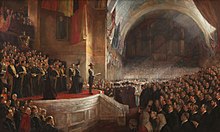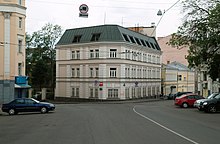Australia–Russia relations
[5] Contacts between Russia and Australia date back to 1803, when Secretary of State for the Colonies Lord Hobart wrote to Governor of New South Wales Philip Gidley King in relation to the first Russian circumnavigation of the globe by Adam Johann von Krusenstern and Yuri Lisyansky.Suvorov commanded by Captain Mikhail Lazarev spent twenty-two days in New South Wales in 1814, when it brought news of Napoleon's defeat, and this was followed up by the 1820 visit of Otkrytiye and Blagonamerenny.[7][10] By the late 1830s, relations between Russia and Britain had deteriorated, and in 1841 the Government of New South Wales decided to establish fortification at Pinchgut in order to repel a feared Russian invasion.[10][13][14] As Australia was engaged in a gold rush in the 1840s and 1850s, in conjunction with the Crimean War between the UK and Russia, paranoia of a Russian invasion gripped the Colony, and Russophobia increased.The corvette visited the cities on a navigational drill under the Commander of the Russian Pacific Fleet Rear Admiral Andrey Alexandrovich Popov, and the ship and crew were welcomed with warmth.After Bogatyr had left the Colony, the Sydney Morning Herald reported on 7 April 1863 that the crew of the ship had engaged in topographical surveys of the Port Jackson and Botany Bay areas, which included investigating coastal fortifications, but this did not raise any eyebrows at the time.[14][15] Anti-Russian sentiment in Australia began to take hold in the Australian media in November 1864 after the publication by The Times in London of an article which asserted that the Colonies were on the edge of a Russian invasion.Australian newspapers, including The Age and Argus, took The Times' claims more seriously and began to write on the need to increase defence capabilities to protect against the threat of a Russian invasion.The reason for the appearance of the Russian warship was humanitarian in nature; the ship's purser was ill and Captain Serkov gained permission to hospitalise Grigory Belavin and remain in port for two weeks to replenish supplies and give the crew opportunity for some shore leave.After the death of Belavin, permission was given to bury him on shore, and his funeral saw the attendance of thousands of Hobart residents, and the locals donated funds to provide for a headstone on his grave.David Syme, the proprietor of The Age, wrote in a series of editorials that the visit of the three ships was associated with a war that was threatening to engulf Britain and Russia, and that the squadron under the command of Avraamy Aslanbegov was in the Pacific in order to raid British commerce.[11] Nicholai Miklukho-Maklai after conducting ethnographic research in New Guinea since 1871 moved to the Australian Colonies in 1878, where he worked on William John Macleay's zoological collection in Sydney and set up Australia's first marine biological station in 1881.In total, three reports were sent to Russia by Miklukho-Maklai, containing information on the growth of anti-Russian sentiment and the buildup of the military in Australia, which correlated with the worsening of Anglo-Russian relations.HMS Nelson was late arriving in Sydney and on 26 January, the day of celebrations, the Rynda orchestra was invited to entertain the public, and the Australian media made the Grand Duke the central focus of the events.The visit was initially reported positively in the press, but after a few days The Age began to campaign for restricting the entry of foreign naval ships into Melbourne, and other articles described the expected war between "semi-barbarous and despotic Russia" and England.Poutyata died of kidney failure following complications from pneumonia a little over a year after his arrival in Australia on 16 December 1894, which saw Robert Ungern von Sternberg being appointed to replace him at the end of 1895.[5][26][27] Nikolai Matyunin, who replaced Sternberg as Consul in 1898, signed an agreement with Dalgety Australia Ltd, which enabled Russian cargo ships to carry the company's pastoral products back to Europe.[5] In 1900, the Imperial Ministry of Foreign Affairs was advised that the Duke and Duchess of York (later George V and Queen Mary) would be visiting Australia for the opening of the Australian Federal Parliament in 1901, whereupon it was viewed as necessary to send a Russian naval vessel, and Gromoboi, captained by Karl Jessen, was ordered to divert to Melbourne on 24 February [O.S.The authorities in Australia were concerned that the Japanese military posed a threat to the national security of the country, and the fear existed even when Japan was an ally of the Entente Powers in World War I.[30][31][32] Abaza wrote to Prime Minister William Hughes on 24 December 1917: "During whatever time I may act here nominally as Consul-General for Russia I shall only represent those of my people who are absolutely faithful to the Allies.[45] HMAS Norman in October 1941 visited Arkhangelsk bringing a British trade delegation from Iceland; marking the beginning of the Lend-Lease program in support of the Soviet Union.[46][47] H. V. Evatt, the Australian Minister for External Affairs on 4 November 1941 wrote in a secret submission to the war cabinet that the Government had received a large number of representations from interested parties since the outbreak of the Russo-German War, and that the major views in support of sending a diplomatic delegation to the Soviet Union included the necessity to provide material and moral support to the Soviet Union and to encourage its resistance against the Germans, the sharing of a common interest in policy towards Japan and the Middle East, and the potential for Australian-Soviet trade, and its importance to the Australian economy.[citation needed] In taking this controversial decision Whitlam also reneged on pre-election commitments made in correspondences to organizations representing emigrees from all three Baltic nations.[101] The Combe–Ivanov Affair was subject to a Royal Commission presided over by Robert Marsden Hope, which saw Prime Minister Bob Hawke giving evidence for 20 consecutive sitting days.The Russian government accepted an offer of Rosaviakosmos on 10 March 2001 to co-operate with the Asia-Pacific Space Centre in developing a spaceport on Christmas Island, an Australian territory in the Indian Ocean.[119] Rory Medcalf, a strategic analyst with the Lowy Institute, stated that Australia could use the uranium deal to apply pressure on Moscow, but in doing so it risked sending messages to countries such as China that it is an unreliable supplier, which would in turn hurt Australian interests.[121] In September 2007, at the Russia–Australia Business Forum in Brisbane, Ian Macfarlane, the Australian Minister for Industry, Tourism and Resources, estimated that Russian investment in Australia was worth between A$5 and 6 billion.[129] In April 2008, Carpenter became the first Western Australian Premier to visit Russia, when he headed a trade delegation for a five-day trip to the country to court more Russian investment in the state.Moscow also warned that it would expand the blacklist to include Australian military officials, business people, experts and journalists who allegedly "incited a negative attitude towards Russia.[149] Gazprom ceased gas supplies to Austria’s OMV on 16 November 2024 after an arbitration dispute, while continuing reduced shipments to Europe via Ukraine, one of the few remaining operational routes set to close by year-end.








AustraliaRussiaEmbassy of Australia, MoscowEmbassy of Russia, CanberraAmbassadorRussianRussian warship NevaSydneyRussian EmpireSoviet UnionAustralian embassy2022 Russian invasion of Ukrainelist of "unfriendly countries"South KoreaUnited StatesEuropean UnionNew ZealandSingaporeSwitzerlandMicronesiaCanadaTaiwanUkraineRussia's invasion of CrimeaMalaysia Airlines Flight 17Pew Research Centerfull-scale invasion of UkraineLowy InstitutePeter the GreatNew HollandEmpireAustralian continentSecretary of State for the ColoniesLord HobartGovernor of New South WalesPhilip Gidley KingAdam Johann von KrusensternYuri LisyanskyBritishwar against NapoleonRussian warship NevaLudwig von HagemeisterPort JacksonGovernorWilliam BlighNorth American coloniesMikhail LazarevNew South WalesNapoleonFabian Gottlieb von BellingshausenMikhail VasilyevAntarcticresearch shipsAntarcticaLachlan MacquarieRussophiliacolonynaturalistexpeditionHartleyOrthodox EasterRussian OrthodoxAustralian Coloniescapture of Paris in 1814Imperial Russian ArmyAlexanderApollonLondonSydney CoveNeutral BayRussian Pointrelations between Russia and BritainGovernment of New South WalesPinchgutQueenscliffPortseaMud IslandsMelbournePort Philip BayTamar RiverLauncestonDerwent RiverSandy BayHobartgold rushCrimean WarRussophobiaAdmiralty HouseFort DenisonPacific Ocean FleetImperial Russian NavyPort of Melbournehonorary consulscorvetteflagshipRussian Pacific squadronAndrey Alexandrovich PopovGovernor of VictoriaHenry BarklyJohn YoungprotocolThe ArgusPort Phillip BaySydney Morning HeraldBotany BayAnti-Russian sentimentAustralian mediaThe TimesThe Agewarshippursershore leaveQueen VictoriaThe MercuryEnglishFrenchUnion Jack21-gun salutegarrisonRussian NavalSaint AndrewAlexander IIAnglesea BarracksGod Save the TsarGod Save the QueenRusso-Turkish War of 1877–1878
